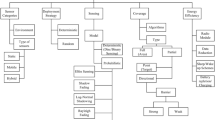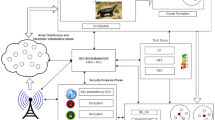Abstract
Duty cycle is a well-known approach for energy saving as well as life time enhancement of a wireless sensor network having scarce energy resources. In this paper, we have achieved energy savings by introducing duty cycle in an aggregation based cooperative-MIMO (CMIMO) framework. In the proposed CMIMO framework, instead of opting for the complete centralized or distributed approach, an optimum number of node performs aggregation and long haul transmissions which not only saves energy but also increases the reliability of the network. The aggregator and the long haul link nodes are selected based on the residual energy level. The role of a node to behave as an aggregator and/or long haul link node is rotated after certain number of rounds and duty cycle is implemented accordingly. This ensures load balancing which eventually leads to lifetime enhancement. The effect of varying the cluster size, the number of aggregator nodes and the long haul links on the average energy consumption have also been analysed. The result shows that by introducing duty cycle in an aggregation based framework contributes to a significant amount of energy savings. On an average 42.50% of energy is saved in the proposed framework when compared CMIMO without any data aggregation. And this energy saving is up to 99% when compared to the conventional single node transmission.

















Similar content being viewed by others
References
Shaikh, F. K., & Zeadally, S. (2016). Energy harvesting in wireless sensor networks: A comprehensive review. Renewable and Sustainable Energy Reviews,55, 1041–1054.
Raghunathan, V., Schurghers, C., Park, S., & Srivastava, M. (2002). Energy-aware wireless micro sensor networks. IEEE Signal Processing Magazine,19, 40–50.
Jain, S., Shah, R., Brunette, W., Borriello, G., & Roy, S. (2006). Exploiting mobility for energy efficient data collection in wireless sensor networks. ACM/Springer Mobile Networks and Applications,11, 327–339.
Pawar, P. M., Nielsen, R. H., Prasad, N. R., & Prasad, R. (2014). Mobility impact on cluster based mac layer protocols in wireless sensor networks. Wireless Personal Communications,74(4), 1213–1229.
Gao, Q., Zuo, Y., Zhang, J., & Peng, X. H. (2010). Improving energy efficiency in a wireless sensor network by combining cooperative MIMO with data aggregation. IEEE Transactions on Vehicular Communications,59(8), 3956–3965.
Xu, Y., Heidemann, J., & Estrin D. (2001). Geography-informed energy conservation for ad hoc routing. In Proceedings of the 7th annual international conference on mobile computing and networking (pp. 70–84).
Deosarkar, B. P., Yadav, N. S., & Yadav, R. P. (2008). Cluster head selection in clustering algorithms for wireless sensor networks: A survey. In IEEE: international conference on computing, communication and networking (pp. 1–8).
Sengottuvelan, P., & Prasath, N. (2017). BAFSA: Breeding artificial fish swarm algorithm for optimal cluster head selection in wireless sensor networks. Wireless Personal Communications,94(4), 1979–1991.
Jia, D., Zhu, H., Zou, S., & Hu, P. (2015). Dynamic cluster head selection method for wireless sensor network. IEEE Sensors Journal,16(8), 2746–2754.
Nguyen, V. D., Nguyen, C. T., & Shin, O. S. (2016). Energy harvesting for throughput enhancement of cooperative wireless sensor networks. International Journal of Distributed Sensor Networks,12(7), 1962397.
Bahbahani, M. S., & Alsusa, E. (2017). A cooperative clustering protocol with duty cycling for energy harvesting enabled wireless sensor networks. IEEE Transactions on Wireless Communications,17(1), 101–111.
Chen, Z., Ma, M., Liu, X., Liu, A., & Zhao, M. (2017). Reliability improved cooperative communication over wireless sensor networks. Symmetry,9(10), 209.
Dohler, M., Said, F., Ghorashi, A., & Aghvami, H. (2001). Improvements in or relating to electronic data communication systems. Publication No. WO 03/003672, priority date 28 June 2001.
Laneman, J. N. (2003). Distributed space time coded protocols for exploiting cooperative diversity in wireless networks. IEEE Transactions on Information Theory,49(10), 2415–2425.
Cui, S., Goldsmith, A. J., & Bahai, A. (2004). Energy-efficiency of MIMO and cooperative MIMO techniques in sensor networks. IEEE Journal on Selected Areas Communications,44(6), 1089–1098.
Cui, S., & Goldsmith, A. J. (2006). Cross-layer design of energy constrained networks using cooperative MIMO techniques. EURASIP Journal of Applied Signal Processing,86(8), 1804–1814.
Kanthimathi, M., Amutha, R., & Kumar, K. S. (2018). Energy efficient differential cooperative MIMO algorithm for wireless sensor network. Wireless Personal Communications,103(4), 2715–2728.
Abbasi-Daresari, S., & Abouei, J. (2016). Toward cluster-based weighted compressive data aggregation in wireless sensor networks. Ad Hoc Networks,36, 368–385.
Krishnan, A. M., & Kumar, P. G. (2016). An effective clustering approach with data aggregation using multiple mobile sinks for heterogeneous WSN. Wireless Personal Communications,90(2), 423–434.
Mantri, D. S., Prasad, N. R., & Prasad, R. (2015). Bandwidth efficient cluster-based data aggregation for wireless sensor network. Computers and Electrical Engineering,41, 256–264.
Shabaneh, A. A., Ali, A. M., Ng, C. K., Noordin, N. K., Sali, A., & Yaacob, M. H. (2014). Review of energy conservation using duty cycling schemes for IEEE 802.15. 4 wireless sensor network (WSN). Wireless Personal Communications,77(1), 589–604.
Çetin, B. K., Prasad, N. R., & Prasad, R. (2013). Maximum lifetime routing problem in duty-cycling sensor networks. Wireless Personal Communications,72(1), 101–119.
Kang, B., Nguyen, P. K., Zalyubovskiy, V., & Choo, H. (2017). A distributed delay-efficient data aggregation scheduling for duty-cycled WSNs. IEEE Sensors Journal,17(11), 3422–3437.
Chen, Q., Gao, H., Cai, Z., Cheng, L., & Li, J. (2018). Distributed low-latency data aggregation for duty-cycle wireless sensor networks. IEEE/ACM Transactions on Networking,26(5), 2347–2360.
Heinzelman, W. R., Chandrakasan, A., & Balakrishnan, H. (2000). Energy-efficient communication protocol for wireless microsensor networks. In Proceedings of the 33rd annual Hawaii international conference on system sciences (pp. 10-pp). IEEE.
Kong, H. Y. (2010). Energy efficient cooperative LEACH protocol for wireless sensor networks. Journal of communication network,12(4), 358–365.
Cui, S., Goldsmith A. J., & Bahai, A. (2003). Modulation optimization under energy constraints. At proceedings of ICC’03, Alaska, USA.
Garfinkel, R. S., & Nemhauser, G. L. (1972). Integer programming. New York: Wiley.
Widmann, M., Bretherton, C. (1999). 50 km daily precipitation for the pacific northwest, 1949–1994. http://tao.atmos.washington.edu/datasets/widmann.
Pattem, S., Krishnamachari, B., Govindan, R. (2004). The impact of spatial correlation on routing with compression in wireless sensor networks. In Proceedings of 3rd international symposium on information processing and sensor networks (pp. 28–35).
Author information
Authors and Affiliations
Corresponding author
Additional information
Publisher's Note
Springer Nature remains neutral with regard to jurisdictional claims in published maps and institutional affiliations.
Rights and permissions
About this article
Cite this article
Asheer, S., Kumar, S. Lifetime Enhancement of a WSN Through Duty Cycle in an Aggregation Based Cooperative MIMO Framework. Wireless Pers Commun 112, 1783–1808 (2020). https://doi.org/10.1007/s11277-020-07127-2
Published:
Issue Date:
DOI: https://doi.org/10.1007/s11277-020-07127-2




